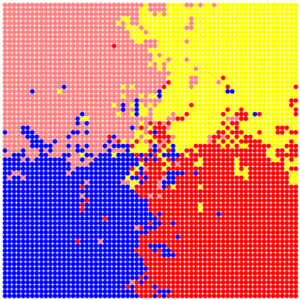More than two biomes
The process of biomes mixing can be generalized to a larger number of biomes. Below are diagrams for which two functions u(y) and u(x) are used with s=10. Depending on their values, one of the four biomes is set on initial distribution (the first figure); after consolidation we get the second figure.
 |
 |
On the triangular lattice, the possible number of biomes in mixing is limited to three, but with taking into account elevations their number may eventually increase.
Use in the project
A typical picture of biomes’ shapes is shown in the following figures. Here are biome samples situated on nine neighboring rhombs in different parts of the planet Serpento.
 |
 |
Area in the vicinity of the point with coordinates (-20.4, -83.1) on land 1 (first diagram), and area in the vicinity of the point with coordinates (3.5, -52.1) on land 4 (second diagram).
Problems and possible solutions
The first thing that is well noticeable is a strong dependence on the ratio of global and local lattice sizes. The rhomb size determines the width of ‘blurring’ of the biomes border.
The overall picture is better when the size of the global lattice gn is several times smaller than the size of the local lattice ln. But at the moment, their working sizes are gn=128 and ln=256, which doesn’t give the best biomes picture. The solution to this can be the implementation of mixing process on a group of rhombs.
Second, the current procedure for the formation of global biome shapes gives only slightly varying in width of primary biomes along their entire extent. This behavior is due to their delimitation along the middle line between the initial curves. This part should be modernized so that the width of biomes will vary within wider limits.
And finally, explicit consideration of various environmental conditions, such as sea currents, the directions of air masses movement, and others is too complicated at this stage. This requires a deep study of earth sciences.